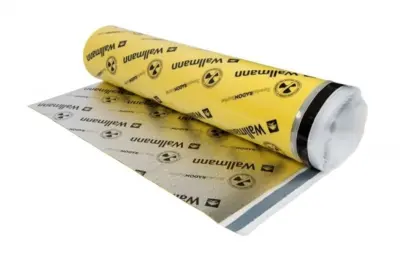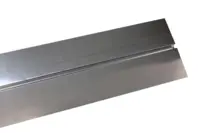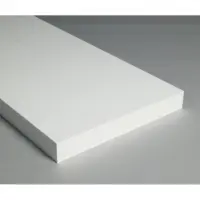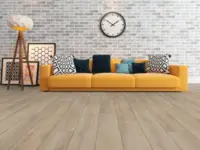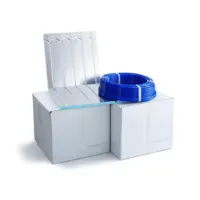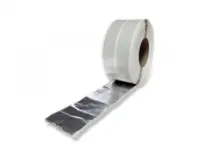No Noise Radonspærre gulvunderlag
3i1 underlag. (Støjdæmpning- Dampspærre - Radonspærre) Specialudviklet Radonspærre gulvunderlag til svømmende gulve, som er testet ved SBI Danmark. Nedbring radon værdier i din bolig ved hjælp af No Noise® Radonspærre. Radon trænger ind i huse, op fra undergrunden. Gulvunderlaget, som monteres under svømmende gulve, har til formål at forbedre beskyttelse i beboelsesejendomme mod indtrængning af radon gas. Underlaget er særdeles velegnet til renoveringsopgaver i huse som oprindelig er bygget uden radonspærre, men også huse med ældre radonspærre.
Tykkelse: 2,0 mm.
Format: 15,0 x 1,0 meter.
Pr. rulle: 15,0 m²
Bæreevne: 6,1 ton/m²
Udligning af ujævnheder: 1,2 mm
Egnet til gulvvarme: Ja
Lydisolering/Gennemslagslyd: Op til 20 dB
Trinlydsdæmpning/Rumklang: Op til 12%
Tæthed sammen med Radon Tape: q30 = 16,6 l/min. (Ved et differenslufttryk på 30 Pa)
Foruden radonspærre er underlaget også med dampspærre og giver en god støjdæmpning.
HUSK: Der skal anvendes special NO NOISE® Radonspærre Tape til topsamlinger og langs væg.
Husk at læse monteringsvejledningen inden montering.
Download:
Monteringsvejledning
Fakta om hvad er radon?
Radon er en naturligt forekommende, radioaktiv gasart, der kan trænge ind i huset fra undergrunden. 350.000 huse i Danmark anslås at have for højt radonniveau. Radon lugter ikke og kan ikke ses eller smages, men det kan ved langvarig påvirkning være sundhedsskadeligt, og det er en medvirkende årsag til ca. 300 tilfælde af lungekræft om året. Sundhedsrisikoen ved radon er cirka 25 gange større for rygere end for ikke-rygere.
Hvor kommer radon fra?
Det meste radon trænger ind i huse gennem revner og sprækker i fundamenter, stuegulv og betondæk, kældergulve, ydervægge i kælder og utætheder ved rørgennemføringer i fundamenter m.v.
Hvad gør jeg ved det?
Måler du over 100 Bq/m3, anbefaler Energistyrelsen, at radonniveauet nedbringes. Ved radonniveauer mellem 100-200 Bq/m3, anbefaler Energistyrelsen, at du nedbringer radonniveauet via forbedringer af ventilation samt tætning af revner i fundamentet og utætheder ved rørsammenføringer. Ved radonniveauer over 200 Bq/m3, kan det være nødvendigt med mere omfattende tiltag, som f.eks. etablering af radonsug (et særligt ventilationssystem under bygningen).
Husk også, at radonniveauet generelt er højere i kælder- og stueplan, hvor der er direkte kontaktflade mellem gulv og jord. Især kælderrum har ofte et dårligere indeklima end resten af huset, og kælderrum er først og fremmest beregnet til opbevaring – ikke til beboelse
Læs meget mere på www.radonguiden.dk eller www.radonfrithjem.dk
Radonsikring er lovkrav i nybyggeri I 1998 blev der indført et krav i bygningsreglementet om, at nyt byggeri skal radonsikres. Er dit hus opført efter 1998, er det således opført med radonsikring. Selvom dit hus er opført efter 1998, kan være for høje radonniveauer i dit hus, hvis radonsikringen ikke fungerer. Det kan være fordi, at der er for lavt ventilation og luftskifte i dit hus, eller hvis den membran i fundamentet, der skal sikre, at der ikke trænger radon ind fra jorden, er gennembrudt. Tal fra Bolius kampagne viser at ca. 30% af testede huse bygget efter 2000 har for højere radon værdi, end myndighederne anbefaler. I Bygningsreglement 2010 er det for nybyggeri præciseret, at kravet om radonsikring skal sørge for, at radonindholdet ikke overstiger 100 Bq/m3 i indeklimaet. Ejeren af et hus, der er opført efter juni 2010, har således krav på at radonniveauet ikke overstiger 100 Bq/m3. Det er den professionelle bygherre, der har ansvaret for, at radonsikringen overholder kravet om max. 100 Bq/m3.

